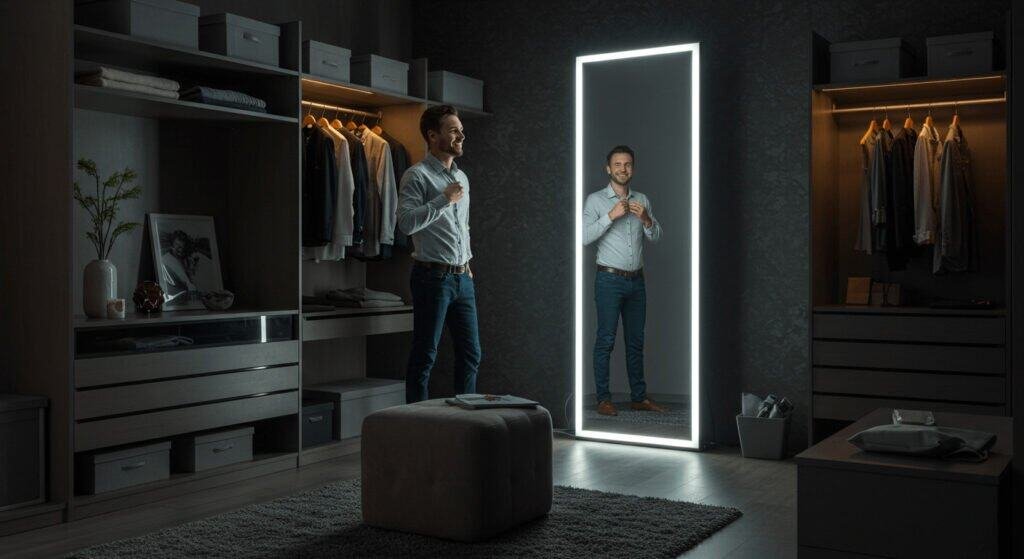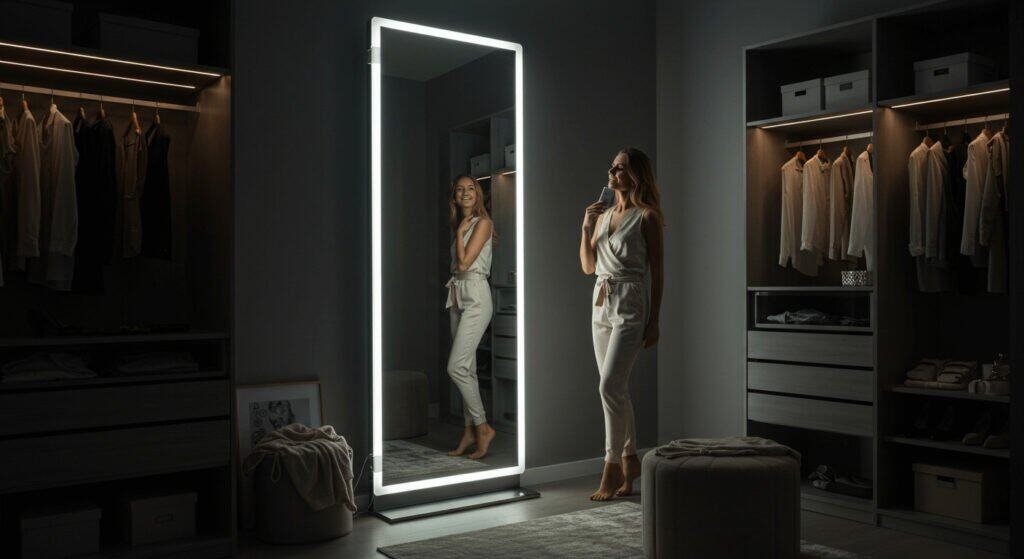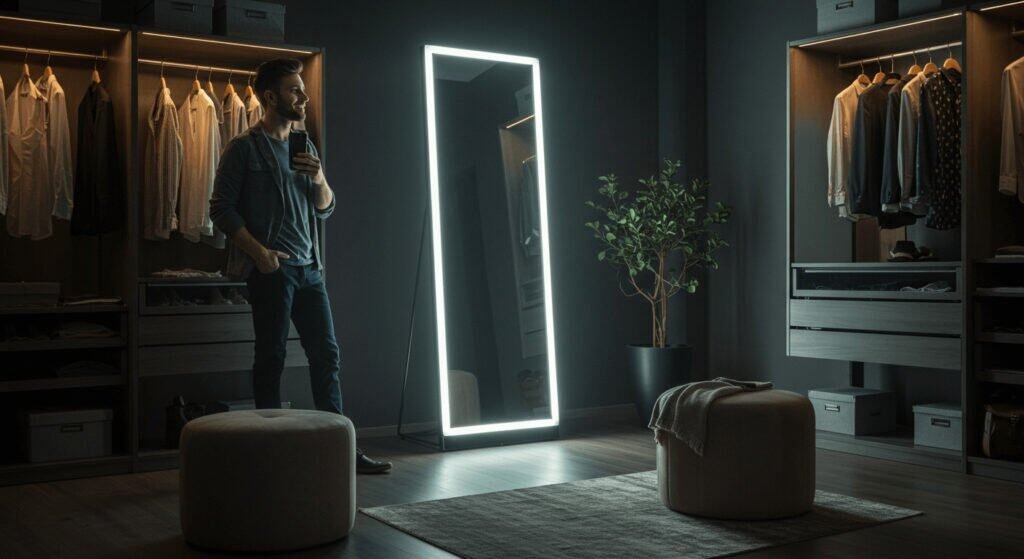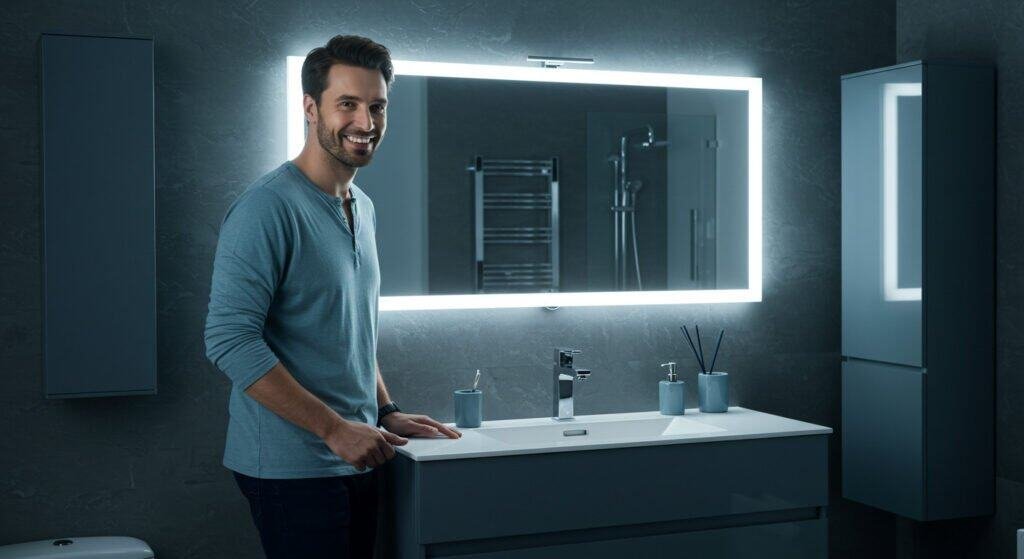What is the size of a full length mirror? Choosing the wrong full length mirror size can leave you with an awkward reflection that cuts off at the knees or overwhelms your space. This sizing mistake costs homeowners and businesses thousands in replacements and missed design opportunities.
The standard full length mirror dimensions typically range from 48 to 72 inches in height and 12 to 18 inches in width. Most residential applications use mirrors measuring 60 inches tall by 16 inches wide, while commercial installations often require larger specifications up to 72 inches in height to accommodate diverse user heights.
Let’s explore comprehensive sizing guidelines to help you make the most informed decision for your specific needs and space requirements.

Standard Full Length Mirror Dimensions
The one size fits all size for a full length mirrors does not work because you have different size people. Between the ceiling and the top of the mirror, and the bottom of the mirror and your head, there is a void. It has to be filled with something. A way to make sure that it looks good every time is to follow the rules.
Standard full length mirror dimensions include heights of 48, 60, and 72 inches paired with widths ranging from 12 to 20 inches. The most popular combination measures 60 inches tall by 16 inches wide, representing approximately 70% of residential purchases according to industry data.
These standardized measurements ensure optimal reflection coverage for users between 5’2″ and 6’2″ in height. Despite different applications and the convenience of purchasing ready-made full length mirrors, many homeowners decide to go the custom route. They can pick the size they want because they know who is using it. They can also pick the frame, the style, and pretty much everything else.
What Size Is Considered Full-Length for a Mirror?
The definition of a full length mirror size is a mirror large enough to see your full body from head to toe when standing at a normal distance.
A mirror qualifies as full-length when it measures at minimum 48 inches in height and 12 inches in width. This specification allows users of average height to see their complete reflection when standing approximately 24 inches from the mirror surface.
However, optimal full-length functionality requires consideration of user demographics and installation height. Mirrors measuring 60 inches or taller provide superior full-body reflection for users across broader height ranges.
Contemporary lighted vanity mirrors and led bathroom mirrors are being made in these larger sizes because invisibility in all directions when you’re standing in front of it at the right distance. They also include extra features like being able to adjust the color temperature, and they include magnification zones.

What Is the Average Height of a Full-Length Mirror?
Typically, the full length mirrors you find in retail spaces or that hang on the back of your closet door are either 48″ tall or 72″ tall. These two heights work for everyone.
The average height of full length mirror installations measures 60 inches, representing the most frequently specified dimension in both residential and commercial projects. This measurement accommodates the majority of users while fitting standard ceiling heights and doorway clearances.
Statistical data from major mirror manufacturers indicates that 60-inch height specifications account for 45% of production volume, followed by 72-inch mirrors at 30% and 48-inch options at 25%. The 60-inch mirror is so popular because it’s the right size to be able to see everything you need to see. Whether you’re putting it in a bedroom or a closet, you definitely want to use a larger mirror. A 60-inch mirror with a bathroom light on it is super popular for vanity lights in the bathroom.
How Long Is Full Length Mirror?
The length on a full-length mirror has to do with being able to see yourself from head to toe.
Full length mirror length typically ranges from 48 to 72 inches, with 60 inches representing the most common specification. This length provides complete body reflection for users ranging from 5 feet to 6 feet 2 inches in height when properly positioned.
Length selection depends on primary user height, installation location, and ceiling clearances. Commercial applications often specify 72-inch lengths to accommodate diverse user populations, while residential installations frequently utilize 60-inch options for space efficiency.
Modern technology in the LED vanity mirrors and the backlit mirrors has kind of changed things. These mirrors have body sensing and come on when you walk up in front of them.

What Is the Best Size Full-Length Mirror?
If you are picking out a full-length mirror for someone else, you should spend a little bit of time talking with them about what they want to do with the mirror. How do they want it to look in the space?
The best size full-length mirror for most applications measures 60 inches in height by 16 inches in width. This specification provides comprehensive reflection coverage while maintaining manageable installation requirements and proportional aesthetics.
However, specific applications may benefit from alternative sizing approaches. Bedroom installations often utilize 72-inch mirrors for enhanced dressing functionality, while bathroom applications may require narrower 12-inch widths to accommodate space constraints.
If you’re looking at led bathroom mirrors, bathroom mirrors with lights, or modern bathroom design mirrors with lights, those are typically going to be taller. For men and women, it’s just nice to have a bigger mirror in the bathroom. The question isn’t so much the height of the mirror—although that same person that had the 6-foot countertops and the tiny thing probably needs a bigger bathroom vanity mirror to see their whole face.
| Application | Recommended Height | Recommended Width | Key Features |
|---|---|---|---|
| Master Bedroom | 72 inches | 18 inches | Full dressing capability |
| Guest Bedroom | 60 inches | 16 inches | Standard functionality |
| Bathroom | 60 inches | 12-14 inches | Space-efficient design |
| Hallway | 60 inches | 16 inches | Traffic flow consideration |
| Closet | 72 inches | 20 inches | Maximum visibility |
What Type of Mirror Is a Full-Length Mirror?
Full-length mirrors encompass various construction types and technological configurations designed to provide complete body reflection capabilities.
Traditional glass mirrors utilize standard silvered backing on float glass substrates, while modern led mirrors incorporate integrated lighting systems with features such as three-color light switching and adjustable color temperature. Advanced full-length mirror types include backlit mirrors with edge lighting and lighted vanity mirrors with perimeter illumination.
Contemporary full-length mirror technology extends beyond basic reflection to include smart functionality such as time and temperature display, Bluetooth music connectivity, and automatic defogging systems. Bathroom light mirrors and vanity mirror with led lights represent significant technological advancement over traditional glass mirror construction. These modern lighted mirrors for bathrooms often feature touch controls, motion sensors, and energy-efficient LED systems that provide superior illumination while maintaining the essential full-length reflection capabilities that define this mirror category.

What Is a Standard Size Mirror vs Full-Length Mirror?
Understanding the dimensional differences between standard mirrors and full-length specifications helps clarify appropriate applications and sizing decisions.
Standard bathroom mirrors typically measure 24 to 36 inches in height and 30 to 48 inches in width, focusing on facial reflection and upper body visibility. Full-length mirror standard size begins at 48 inches in height with proportionally narrower widths designed for complete body reflection.
The fundamental distinction lies in intended functionality and viewing requirements. Small bathroom mirrors serve grooming and hygiene tasks, while full-length mirrors provide comprehensive appearance assessment capabilities. Modern bathroom mirror technology increasingly blurs these distinctions through modular designs and integrated lighting systems. Bathroom vanity mirrors and lighted vanity mirrors for bathroom applications often bridge sizing gaps through extended height specifications that approach full-length functionality while maintaining vanity-specific features such as magnification zones and task lighting optimization.
| Mirror Type | Typical Height Range | Typical Width Range | Primary Function |
|---|---|---|---|
| Standard Bathroom | 24-36 inches | 30-48 inches | Grooming, hygiene tasks |
| Vanity Mirror | 28-40 inches | 32-60 inches | Detailed grooming, makeup |
| Full-Length | 48-72 inches | 12-20 inches | Complete body reflection |
| Wall Mirror | 36-48 inches | 24-36 inches | Decorative, partial reflection |
What Size Mirror Makes a Room Look Bigger?
Strategic mirror sizing can significantly enhance perceived room dimensions through optical illusion and light reflection principles.
Mirrors that measure 60 inches or larger in height create the most dramatic space-enlarging effects by reflecting substantial portions of the room and maximizing light distribution. Wider mirrors measuring 20 inches or more further enhance this effect by capturing broader viewing angles.
The space-enlarging impact depends on mirror placement, lighting conditions, and surrounding décor elements. Wall mirror with lights and light up vanity mirror installations provide dual benefits of size perception enhancement and improved illumination quality. Led light mirror vanity configurations particularly excel in smaller bathrooms where space optimization remains critical. Rectangular bathroom mirrors with dimensions exceeding 60 by 18 inches create powerful visual expansion effects while maintaining practical functionality for daily use.

How to Know Mirror Size and Choose the Right One?
Selecting appropriate mirror dimensions requires systematic evaluation of space constraints, user requirements, and functional objectives.
Measure your available wall space, ceiling height, and intended viewing distance to determine maximum feasible mirror dimensions. Consider user heights within your household and add 12 inches to the tallest person’s height to establish minimum mirror height requirements for full-body reflection capability.
Factor installation method, surrounding fixtures, and traffic flow patterns into your sizing decision. Bathroom vanity lights and existing electrical configurations may influence led mirror selection and placement options. Consider future needs and potential room modifications that might affect mirror positioning or replacement requirements.
Modern bathroom mirror technology offers customization options that allow precise dimensional matching to architectural specifications while incorporating advanced features such as integrated lighting, defogging systems, and smart controls that enhance functionality beyond basic reflection capabilities.
What Is the Difference Between a Full-Length Mirror and a Wall Mirror?
The distinction between full-length and wall mirrors encompasses dimensional specifications, mounting methods, and intended applications.
Full-length mirrors prioritize vertical dimensions with heights typically exceeding 48 inches and relatively narrow widths designed for complete body reflection. Wall mirrors emphasize broader horizontal dimensions with varied height specifications intended for decorative enhancement and partial reflection coverage.
Mounting approaches differ significantly between these mirror types. Full-length mirrors often utilize floor-standing frames or specialized wall mounting systems designed to support tall, narrow configurations. Wall mirrors employ standard picture hanging methods or integrated mounting brackets suitable for broader, shorter proportions.
Mirrors with black frame designs and rectangular bathroom mirrors represent popular wall mirror applications, while room mirror ideas increasingly incorporate full-length specifications for maximum visual impact. Led mirror technology applies to both categories through customized lighting integration that enhances functionality while maintaining category-specific dimensional characteristics.

Conclusion
Standard full length mirror dimensions of 60 inches in height by 16 inches in width provide optimal functionality for most residential and commercial applications. Consider your specific space requirements, user demographics, and desired features when selecting mirror dimensions to ensure maximum satisfaction and long-term value from your investment.
- Clik here to know What Is Copper Free Mirror?
- If you donot know how too choose the right bathroom height click here.
- Know more about LED bathroom mirror Problems
- Clik here to know why Touch Sensor Mirror Not Working
- Clik here to know What Are Standard Vanity Mirror Sizes?
- Clik here to know Why Are Mirrors So Expensive?
- Clik here to know Do LED Mirrors Need Electricity?
- Clik here to know Is a Lighted Mirror Enough Light for a Bathroom?
- Find out 10 Common LED Bathroom Mirror Problems Click Here



